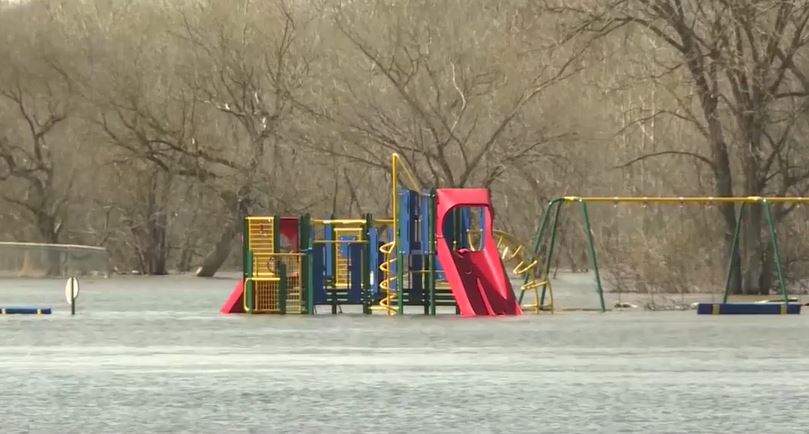Flooded Peguis First Nation wants permanent infrastructure for protection

Posted May 7, 2022 12:32 pm.
The marshy delta of Manitoba’s Fisher River was not the original home of Peguis First Nation. But having been relocated there more than a century ago after an illegal land transfer, and facing increased flooding in recent decades, the community is hoping to get some permanent infrastructure for protection.
“We have asked for a diversion (channel). We have asked for ring diking. We have asked for elevated roads … but nothing has occurred,” Chief Glenn Hudson said in an interview from the community that has been swamped again this year.
A reservoir upstream that might hold back water during flooding would be another option, he said
BACKGROUND: More than 1,000 people evacuated from Peguis First Nation due to flooding
More than 1,400 of 3,500 residents have left the reserve since the Fisher River spilled its banks last week. Most have gone to Winnipeg, 60 kilometres to the south.
Hundreds of homes have been surrounded by water or have been flooded. Residents who have stayed are trying to keep homes protected with sandbags and are ferrying food and people by boats.
Manitoba faces the threat of flooding almost every year. Many communities are protected by dikes, diversion channels or reservoirs. The town of Morris in the Red River Valley, with a much smaller population than Peguis, is one of many with a ring dike that can keep the community dry even when surrounding farmland and roads are submerged.
Hudson, who has been chief for all but two of the last 15 years, said the federal and provincial governments have been in talks about possible permanent flood protection.
It would be less expensive than frequent evacuations and cause much less stress in the community, he said.
Ottawa pays for evacuations and temporary emergency measures, including sandbagging. It also provides compensation after flooding.
READ MORE:
- More rain expected as Southern Manitoba remains under water
- Fisher River rises, causing more damage in flooded Manitoba community
- Swollen rivers, flooded roads prompt evacuations in some areas of Manitoba
The federal government indicated Friday it is willing to look at permanent protection.
“There is a history of flooding in this community and we have some important work to do once we get through this crisis period to talk about the future of supporting Peguis in resiliency efforts,” Indigenous Services Minister Patty Hajdu said in Ottawa.
Peguis was originally the St. Peter’s reserve and was situated on good agricultural land closer to Winnipeg. The federal government did a land transfer in 1907 that resulted in the First Nation being moved to its current location.
Peguis has other smaller reserves as well.
The federal government conceded in 1998 that the transfer was illegal. The two sides reached a settlement 11 years later.
While this year’s flooding is the worst in a long time, the First Nation has faced high water and evacuations frequently over the last few decades, most notably in 2009 and 2011. In 2017, when flooding was a non-issue in most of Manitoba, Peguis was still affected and more than 100 people left.
Hudson said drainage improvements upstream since the 1970s have made things worse by allowing water to flow to Peguis more quickly.
“That improvement stops at the south end of our First Nation … and therefore (water) bottlenecks when it comes through.”
MORE ON MANITOBA FLOODS
The federal government has provided help to flood-proof some of the most vulnerable homes and has cost-shared a study with Manitoba.
“The … study concluded mitigation measures were possible, but would likely cost several hundred million dollars and would likely not prevent all types of flooding,” Matthew Gutsch, a spokesman for Indigenous Services Canada, wrote in an email.
Jay Doering, a flood expert and professor of civil engineering at the University of Manitoba, said a community ring dike for the sprawling area the reserve covers would be costly.
“What probably makes more economic sense is what was done in the Red River Valley following the 1997 flood,” Doering said. “The majority of those homes were put up on pads.”
The 1997 flood – often called the flood of the century – prompted a new requirement that homes and flood defences be elevated to withstand water at least 60 centimetres above the 1997 level.
A dam or other project that could hold back water upstream could also be feasible for Peguis, Doering said.








